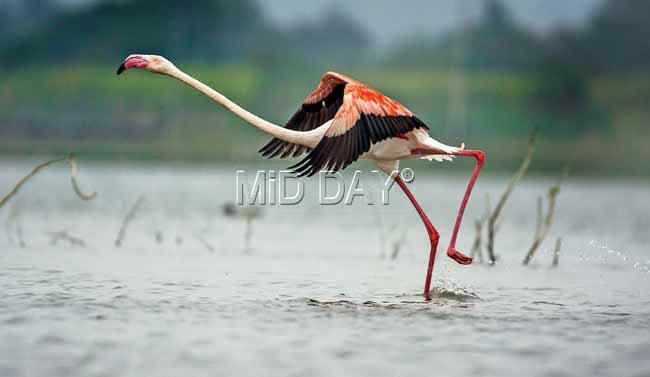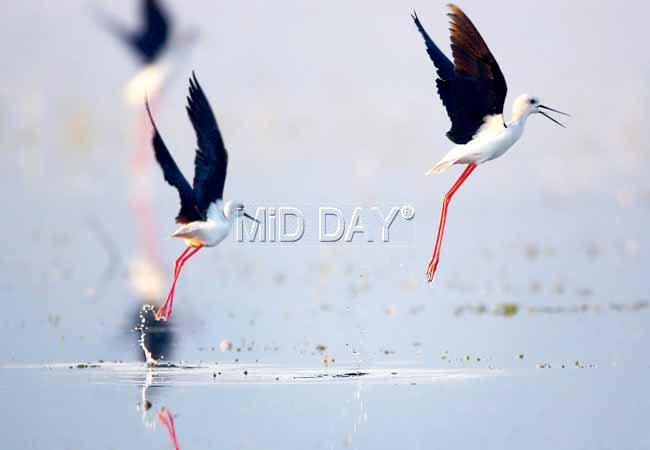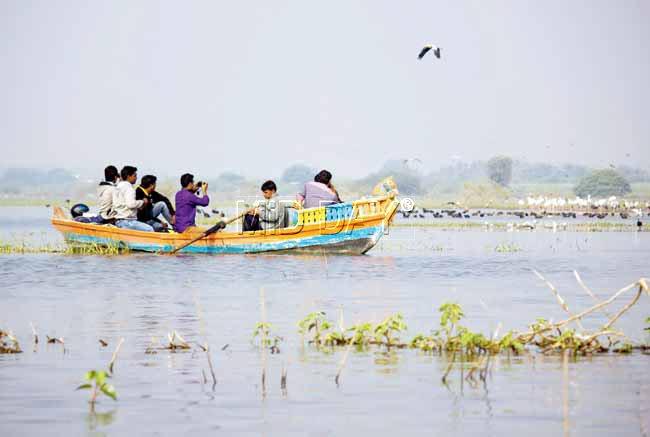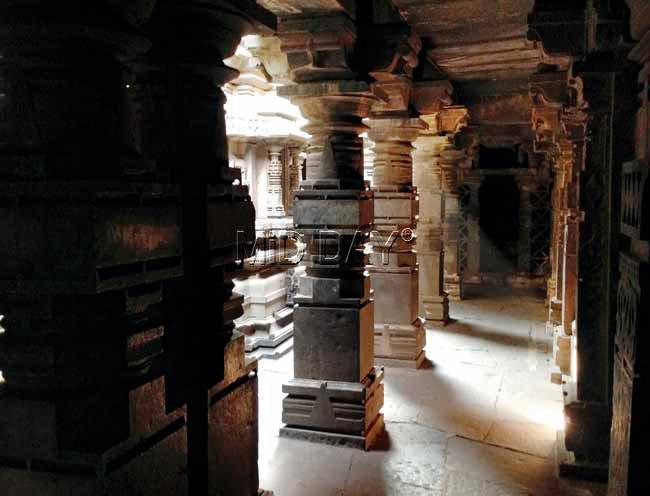A pink carpet trail, dotted with over 50 migratory birds make Bhigwan a birder’s delight. Add Gazelle-spotting and a visit to a 13th century temple, and you’re set for a vibrant weekend escape

Ujjani Dam
Come winter, and the joy of watching hundreds of Greater Flamingoes in Bhigwan is a sight to behold. To relive the experience this year, we signed up with The Western Routes — a Pune-based travel company that organises day excursions. Also, on the itinerary were stops to Mayureshwar and Bhuleshwar.
ADVERTISEMENT

A flamingo walks over the waterbody at Ujjani Dam in Bhigwan. PIC/ Vikram Vyawahare
Feather flutter
We hit the Pune-Solapur Highway at dawn. After a yummy Maharashtrian breakfast, we drove towards Bhigwan, a dusty town about 100 km from Pune. We spotted Moorhens, Ibises, Open Bill Storks, Grey Herons and common wetland birds wade in small ponds on either side of the road. Our final destination to spot migratory birds including flamingos, was the backwaters of Ujjani Dam built on the Bhima River around Bhigwan. The vast, shallow expanse makes it one of Maharashtra’s best wetlands. Many species from Russia, Europe, Siberia and the Himalayas migrate to breed or feed here. A recent report revealed that over 50 species of migratory birds make these backwaters their home in winter. These fertile waters also serve as a good feeding ground for flamingos who migrate from Gujarat.

Black Winged Stilt. PIC COURTESY/nikhil wadatkar
Diksal and Kumbharwadi are two areas to spot birds here. We went to Diksal, and after a short drive, we arrived at a fishermen’s settlement. Anil Nagare and his family welcomed us; they were to be our guides. Stepping into their handpainted boats, Nagare and his cousins manoeuvred these boats to the exact location, to spot birds.
After a while, we heard faint warbling squawks and realised that the Flamingos were near. Soon, we spotted a flock of over 300 Greater Flamingos — some preening, others feeding and a few sleeping on one leg, even! The Western Routes’founder Jayesh Paranjape told us that this shade of pink is from carotenoids could be from either feeding directly on the blue-green algae or on animals that have digested the algae. We observed these flamingos with our binoculars for 45 minutes. Some tourists got greedy and shifted their boats a too close to the birds. Quickly, the birds took off to a safer, private location. We returned to land where Nagare's wife served us hot tea. With a promise to return next year, we stopped at Baramati for our lunch break.

Birdwatching in Bhigwan. PIC COURTESY/Vidyuth Singh
Chinkara calling
After a filling thali lunch, we hit the road, to spot the Chinkara or Indian Gazelle. The Mayureshwar Wildlife Sanctuary is a 500-hectare, dry grassland near Supe village. It was declared a wildlife sanctuary, as it is a safe refuge for Chinkaras. More recently, there have been reports of wolves, foxes and hyenas being spotted in the area by locals.

The Chinkara or Indian Gazelle
Despite relentless human pressure, the sanctuary survives. As soon as we entered the space, we were greeted by a herd of Chinkaras. It was a treat to watch these graceful creatures from such close range. After our fill of watching this, we headed to our last stop: Bhuleshwar Temple.

Bhuleshwar Temple. Pics Courtesy/Shekhar KarambelkaR, Jayesh Paranjape
Temple talk
Bhuleshwar is a 13th century Shiva temple built during the reign of the Yadavas. Situated on a hill, it also is home to the ruins of Mangalgad fort. The Peshwas built the shikhar (summit) and the temple’s façade in the 17th century. The style is influenced by Mohammedan architecture; the minarets being the identifying factor here. Inside, we were struck by the rock carvings including Nandi in the mandap, a goddess Kali sculpture with snakes as her ornaments and a scorpion in her belly. The walls depict scenes from the Mahabharata. We soaked in the architecture for over an hour, before heading back to Pune.
 Subscribe today by clicking the link and stay updated with the latest news!" Click here!
Subscribe today by clicking the link and stay updated with the latest news!" Click here!






